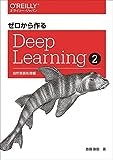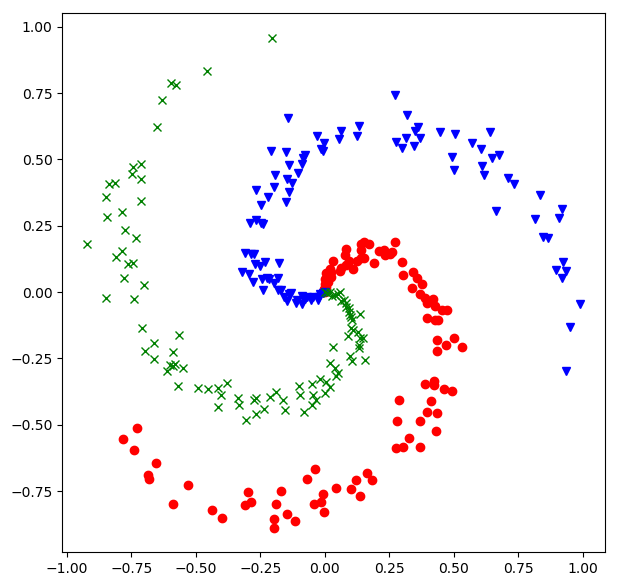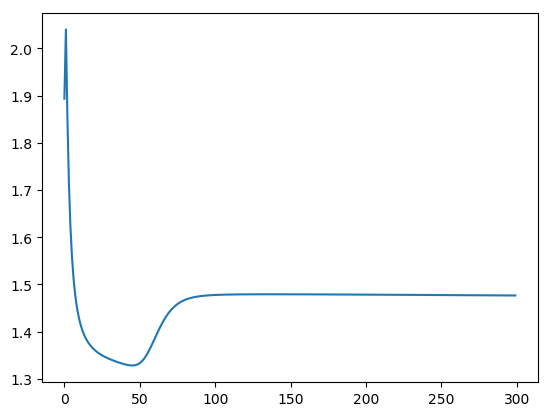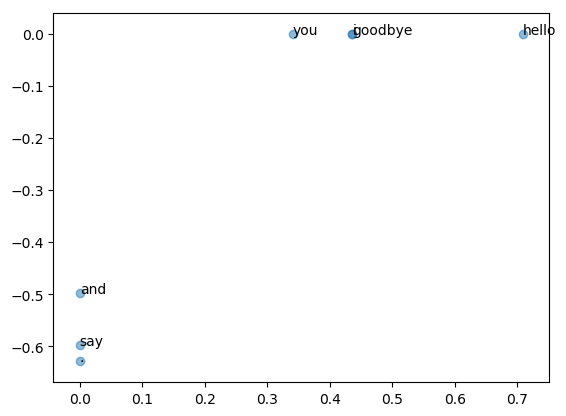この記事は Julia Advent Calendar 2018 の14日目の記事です。
TL; DR
- ゼロから作るDeep Learning② 自然言語処理編の一部を,Julia 1.0.2の習得を含めてやってみます.
ゼロから作るDeep Learning ❷ ―自然言語処理編
posted with amazlet at 18.12.10
斎藤 康毅
オライリージャパン
売り上げランキング: 1,084
オライリージャパン
売り上げランキング: 1,084
準備
-
@antimon2 さんが「ゼロから作るDeep Learning」で作成していたDLScratch.jlを見て雰囲気を掴む
- ただしJuliaのバージョンが当時のもの (0.5.x) なので,1.0.2では動かない部分もある
- これをForkしてきて1.0.2で動く雰囲気のコードを作成: https://github.com/cocomoff/DLScratch.jl
- よくハマったポイント
- broadcastに関して呼び出し方の変更(expとexp.)
- パッケージの整理(例. using LinearAlgebraが必要)
- 型の定義方法(immutable -> struct, mutable structなど)が変更
- ジェネリクスの型パラメータ{T}の受け渡し方法
- 今まで: function{T}()
- 最近の: function() where {T}
- 他にもいくつかなくなった関数がある(名前変更含む)ので,その都度調べて再実装
1章
- Pythonで作成したspiral dataをJuliaで読めるようにする
- Julia 1.0.2 + PyPlotでの可視化
using PyPlot
using DelimitedFiles
X = readdlm("data/sprial.dat")
X1 = X[1:100, :];
X2 = X[101:200, :];
X3 = X[201:end, :];
plot(X1[:, 1], X1[:, 2], "ro")
plot(X2[:, 1], X2[:, 2], "bv")
plot(X3[:, 1], X3[:, 2], "gx")
- SpiralとTwoLayerNet
- ロスが収束していないのでどこか悪い感じがする
自然言語処理っぽい操作を行う
2章
- 行列操作はPython/Numpyと同じ形式でほとんど可能(using LinearAlgebra)が必要
- 前処理
using LinearAlgebra
text = "You say goodbye and I say hello."
text = lowercase(text)
text = replace(text, "." => " .")
words = split(text, " ")
word_to_id = Dict{String, Int}()
id_to_word = Dict{Int, String}()
for word in words
word = String(word)
if !haskey(word_to_id, word)
new_id = length(word_to_id)
word_to_id[word] = new_id
id_to_word[new_id] = word
end
end
@show word_to_id; # word_to_id = Dict("say"=>1,"goodbye"=>2,"you"=>0,"hello"=>5,"."=>6,"and"=>3,"i"=>4)
@show id_to_word; # id_to_word = Dict(0=>"you",4=>"i",2=>"goodbye",3=>"and",5=>"hello",6=>".",1=>"say")
- 共起行列と類似度の計算
function create_co_matrix(corpus, vocab_size; window_size=1)
corpus_size = length(corpus)
co_matrix = zeros(Int64, vocab_size, vocab_size)
for (idx, word_id) in enumerate(corpus)
for i in 1:window_size
left_idx = idx - i
right_idx = idx + i
if left_idx >= 1
left_word_id = corpus[left_idx]
co_matrix[word_id, left_word_id] += 1
end
if right_idx <= corpus_size
right_word_id = corpus[right_idx]
co_matrix[word_id, right_word_id] += 1
end
end
end
return co_matrix
end
function cos_similarity(x, y; ϵ=1e-8)
nx = x ./ sqrt(sum(x .^ 2) + ϵ)
ny = y ./ sqrt(sum(y .^ 2) + ϵ)
return dot(nx, ny)
end
# example
C = create_co_matrix(corpus, 7)
c0 = C[word_to_id["you"], :];
c1 = C[word_to_id["i"], :];
println(cos_similarity(c0, c1))
# 0.7071067758832467
- PPMIやSVD
- PPMIでは普通にfor文をかいているけど,Pythonより安心できる(個人差あり)
function PPMI(C; verbose=false, ϵ=1e-8)
M = zeros(Float64, size(C))
N = sum(C)
S = sum(C, dims=1)
total = size(C)[1] * size(C)[2]
count = 0
for i in 1:size(C)[1]
for j in 1:size(C)[2]
pmi = log2(C[i, j] * N / (S[j] * S[i]) + ϵ)
M[i, j] = max(0, pmi)
if verbose
count += 1
if count % (total // 100) == 0
println("$(100 * cnt / total) done")
end
end
end
end
return M
end
# SVDもそのまま
W = PPMI(C)
U, S, V = svd(W)
# PyPlotで描画 (ほとんどPythonと同じ)
figure()
for (word, wid) in word_to_id
annotate(word, (U[wid, 1], U[wid, 2]))
end
scatter(U[:, 1], U[:, 2], alpha=0.5)
5章
-
RNNの実装をやってみる.PythonとDLScratch.jlを参考にすると次のようになる.
- 1つのRNNユニットなので,例えばPyTorchで言うところのRNNCellに相当する
-
Notebookで丁寧にデバッグしてみる
例えば$h_{t}$を計算する式とjuliaとpythonを比較してみる
- 式
$$h_{t} = \tanh(h_{t-1}W_h + x_t W_x + b)$$
- Python
t = np.dot(h_prev, Wh) + np.dot(x, Wx) + b
h_next = np.tanh(t)
- Julia
t = h_prev * rnn.Wh + x * rnn.Wx .+ b
h_next = tanh.(t)
RNNCell全体の実装
mutable struct RNN{T}
Wx::AbstractMatrix{T}
Wh::AbstractMatrix{T}
b::AbstractMatrix{T}
dWx::AbstractMatrix{T}
dWh::AbstractMatrix{T}
db::AbstractMatrix{T}
# self.cache @ python
x::AbstractMatrix{T}
hp::AbstractMatrix{T}
hn::AbstractMatrix{T}
function (::Type{RNN})(Wx::AbstractMatrix{T}, Wh::AbstractMatrix{T}, b::AbstractMatrix{T}) where {T}
layer = new{T}()
layer.Wx = Wx
layer.Wh = Wh
layer.b = b
layer.dWx = zeros(size(Wx))
layer.dWh = zeros(size(Wh))
layer.db = zeros(size(b))
layer
end
end
function forward(rnn::RNN{T}, x::AbstractMatrix{T}, h_prev::AbstractMatrix{T}) where {T}
# Eq.(5.9)
t = h_prev * rnn.Wh + x * rnn.Wx .+ b
h_next = tanh.(t)
rnn.x = x
rnn.hn = h_next
rnn.hp = h_prev
return h_next
end
function backward(rnn::RNN{T}, dh_next::AbstractMatrix{T}) where{T}
x, h_prev, h_next = rnn.x, rnn.hp, rnn.hn
dt = dh_next .* (1 .- h_next .^ 2)
dh_prev = dt * Wh'
rnn.dWh = h_prev' * dt
rnn.dWx = x' * dt
rnn.db .= sum(dt, dims=1)
dx = dt * Wx'
return dx, dh_prev
end
まとめ
- 行列の形に気をつけながら書いていくと,いい感じに書いていける
- 個人的にはブロードキャストと行列の型がイマイチ脳みそにハマってないのか,しょっちゅうバグを起こしてしまった
- DLScratch.jlが最高に参考になる(感謝)
- 現状DLScratch2.jlを書いてみているけど,ソースコード/Notebookをちゃんと整理したらまともに更新します…(休みがいろいろ重なって間に合わなかった.12月中に期待)



